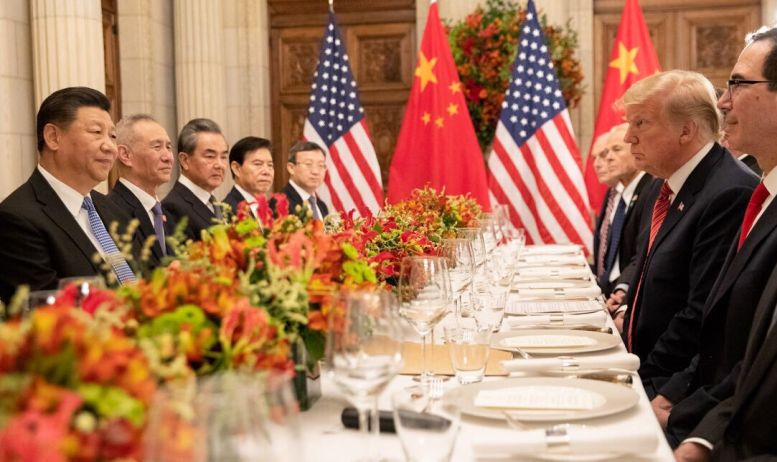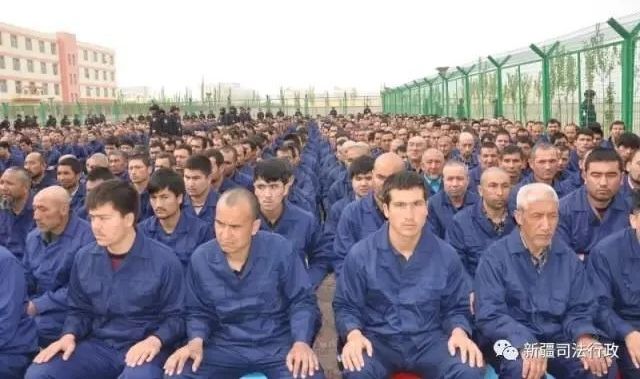‘Liberation Day’ nightmare is scaled back for 90 days but what comes next?
China and the US have de-escalated their trade war at least for the short term. Talks between the two sides on 10–11 May in Geneva produced a 90-day pause until 10 August from astronomical triple-digit tariffs. Both sides agreed to a 115-percentage point reduction in tariff levels. They also set up a “consultation mechanism”, a fancy term for more talks.
Contrary to Trump’s exaggerated statements, this is not a trade deal, let alone a “total reset with China” as he claimed in a social media post. Rather, the Geneva agreement showed the extreme pressure on both sides, which forced them to seek a truce. The two regimes have stepped back from a full-scale economic showdown that went too far and escalated too fast. But neither regime seeks a return to the previous status quo or believes this to be possible.
The imperialist power interests of both sides including their long-term military ambitions force them to drastically cut back their economic interdependence, to pursue further decoupling, a process that will accelerate regardless of last weekend’s truce. But it shows that neither the US or China are currently ready or strong enough to withstand a de facto trade embargo, which is what materialised as Trump’s regime recklessly raised tariffs to historic levels in an attempt to show strength. The de-escalation in Geneva leaves none of the underlying issues resolved.
Given the blowback, especially in financial markets, it is unlikely the US will revert to triple-digit tariffs after the 90-day pause expires, although a smaller yet still substantial tariff increase is one possibility. Whatever form it takes, increased economic warfare is implicit in the situation and the prospects of a permanent US-China deal are close to non-existent. This is a power struggle between the world’s current hegemon US imperialism and its main challenger Chinese imperialism; it is not fundamentally about trade deficits (whatever Trump may believe).
Trade war is not over
The agreement leaves the latest (i.e. Trump 2.0) US tariffs against China at 30 percent and China’s retaliatory tariffs against the US at 10 percent. Although the US has been forced to step back more than once in the past month, the massive trade war launched by Trump on ‘Liberation Day’ 2 April is far from over. US tariffs are still higher than at any time in the past 100 years. Factoring in previous tariffs from the Biden and Trump 1.0 era, China now faces average tariffs of around 40 percent, according to Capital Economics, while the average US tariff for most countries is between 8 percent and 14 percent.
Therefore, while stock markets predictably soared on the news of the US-China de-escalation, it provides only a temporary respite. New flare ups are possible on several fronts. And permanent damage has already been done, not least to the US itself, as a result of Trump’s trade policies. These have further destabilized an already dangerously unstable capitalist world system.
The US economy, which contracted -0.3 percent in the first quarter of 2025, is on the edge of recession. US inflation (which Trump boasted he would eliminate) is predicted by BNP Paribas to trend back towards 4 percent next year. This is a bleak economic scenario even without further Trump-induced or other shocks. A fall in output with inflation is known as stagflation.
Chaos, setbacks and fake trade deals
The Geneva agreement is the latest and by far the most significant climbdown in a string of climb downs by Trump over the past few weeks. On 9 April, barely hours after they officially started, Trump was forced to pause all so-called reciprocal tariffs against some 90 countries with the exception of China. The retreat was a panic measure because US financial markets had begun to go into meltdown. A few days later, Trump also diluted his 145 percent China tariffs, announcing exemptions on around one-fifth of Chinese imports, including smartphones and laptops, for which China produces half and 70 percent of global exports respectively.
Trump has repeatedly made claims that new trade deals with dozens of countries are imminent, but this is more exaggeration. The only deal announced to date is with the UK’s Starmer government, and this is a provisional document that explicitly states it is “non-binding.” Trade agreements between states normally take months to negotiate, even years in some cases. Trump’s government is clearly in a hurry to create positive headlines at the expense of substance. The agreement reached with China in Geneva contains even less, it merely suspends the extreme tariffs which Trump himself created.
To describe Trump’s trade tactics as messy, unplanned and contradictory would be a huge understatement. Of course, he is claiming the US-China tariff pause as a “win.” But in reality, it is Trump who has been forced to retreat. He barreled headlong into a full-blown trade embargo against the “world’s factory” (China accounts for 29 percent of world manufacturing) with little real understanding of how it would impact the US economy. This was summed up by his remark that children in the US would be fine with, “two dolls instead of 30 dolls.” From a billionaire this is a statement with overtones of Marie Antoinette.
The Trump administration believe that as the US has the biggest trade deficits, it had superpowers to subdue its economic rivals. Trump even believes trade policies can solve actual wars — whether over Taiwan (last year he threatened China with 150 percent tariffs if it invaded Taiwan, which has not aged well) or Kashmir (he claims his tariff policies were the key to the recent India-Pakistan ceasefire). These quack theories are being disproved before the eyes of the world, but that doesn’t mean Trump & Co have learned anything or will change course.
Who blinked first?
The question of which side “won” the US-China tariff standoff is being hotly debated in the world’s media. This question has a certain significance in terms of what happens next, who takes away an advantage from the Geneva talks, but that factor should not be blown out of proportion.
In reality, both the US and Chinese regimes were shown to be more desperate for a de-escalation than their propaganda showed. Both claimed the Geneva talks were proposed by the other side, to avoid being seen as weak. Both wished to project strength and confidence. But China was already experiencing large scale factory shutdowns in export-dependent provinces like Guangdong and the threat of millions of job losses, and the US was facing recession — a danger that has not abated — and “empty shelves,” without the goods that China produces.
The scale of disruption already caused is shown by the fact that on Friday 9 May, on the eve of the Geneva talks, not a single cargo ship left China for the US West Coast, something not seen since the pandemic. Now, following the tariff cuts, freight costs are set to rise dramatically as all available container ships are being booked to restart trans-Pacific shipments.
Certainly, in terms of the immediate optics, the Chinese regime will feel satisfied with this outcome. Hu Xijin, a right-wing nationalist and pro-CCP (the so-called Communist Party) commentator, called it “a great victory for China.” But official CCP statements have been notably more low-key. It is under huge pressure from a dire economic situation, with worsening deflation, ‘Japanification’ (prolonged slow growth or stagnation), and an unemployment timebomb among the young.
China made no new concessions at the talks (as far as we know) in return for the lowering of Trump’s 145 percent tariffs, other than reducing its own tariffs by an equal amount. “America has given China a strangely good tariff deal,” declared The Economist. But Beijing will also have no illusions that this dip in the conflict is only temporary, and that bigger trouble lies ahead.
“This is 100 percent a retreat by the US, not a Chinese cave,” Scott Kennedy of the Center for Strategic and International Studies told Reuters. “The US was the one that launched the trade war and escalated it. The Chinese retaliated and they’ve only withdrawn their retaliatory measures,” he commented.
Alicia García-Herrero, chief Asia-Pacific economist at French investment bank Natixis, gave a similar verdict: “The US blinked first. It thought it could raise tariffs almost infinitely without being hurt, but that hasn’t been proven right.”
Demands on China?
The capitalists worldwide will breathe a sigh of relief over this agreement, which kicks a very big can down the road, but only for 90 days. Noticeably absent from the White House propaganda surrounding this agreement are any specific demands on Beijing about removing so-called non-tariff barriers. These amount to the dismantling of China’s state capitalist economic model: eliminating subsidies, the dominance of state-owned companies, capital and currency controls, and the CCP’s control of the banks.
Trump alluded to this when he claimed that during the Geneva talks China “agreed to open up”, adding that “We have to get it papered, but they’ve agreed to open up China.” This was certainly not “agreed”, and there is zero chance of this happening. The CCP regime is never going to make such far-reaching concessions to the US because these would imperil the very foundation of its dictatorship. To rule China, the CCP requires a high degree of economic and political control.
During Trump’s first term, the Chinese regime used its traditional delaying tactics and the art of being vague to let the clock tick towards the next US election, increasing Trump’s desperation for some kind — any kind — of deal. Trump settled for China’s offer to spend $200 billion on increased imports from the US over two years, mostly farm goods and energy, in what became known as the “phase one trade deal.” China’s purchases never came close to $200 billion — the deal was only 58 percent fulfilled according to the Peterson Institute for International Economics. Trump blames this failure on Joe Biden and the pandemic. Something based on the “phase one” deal may be what Trump officials now want to pursue.
The capitalist system is living on borrowed time, with Trump’s chaotic and reactionary policies just the most recent symptoms of a deeper sickness. Workers cannot look for solutions in capitalist free trade or capitalist protectionism, which are two sides of the same coin. Our answer has to be organised mass struggle to overthrow capitalism and replace it with working class control and planning of the economy and international socialism.



